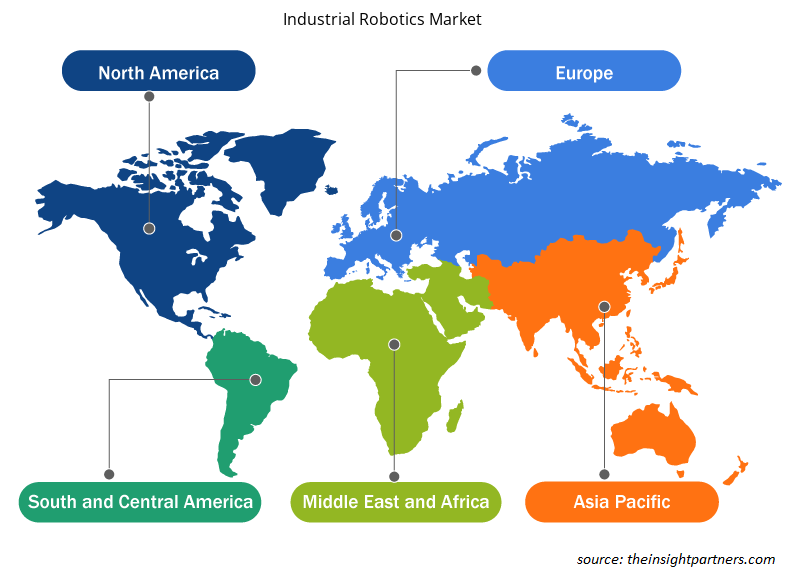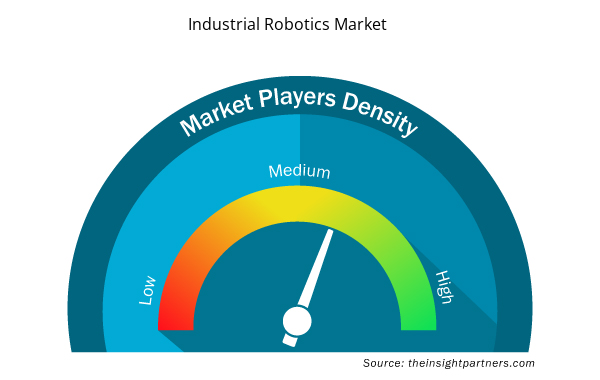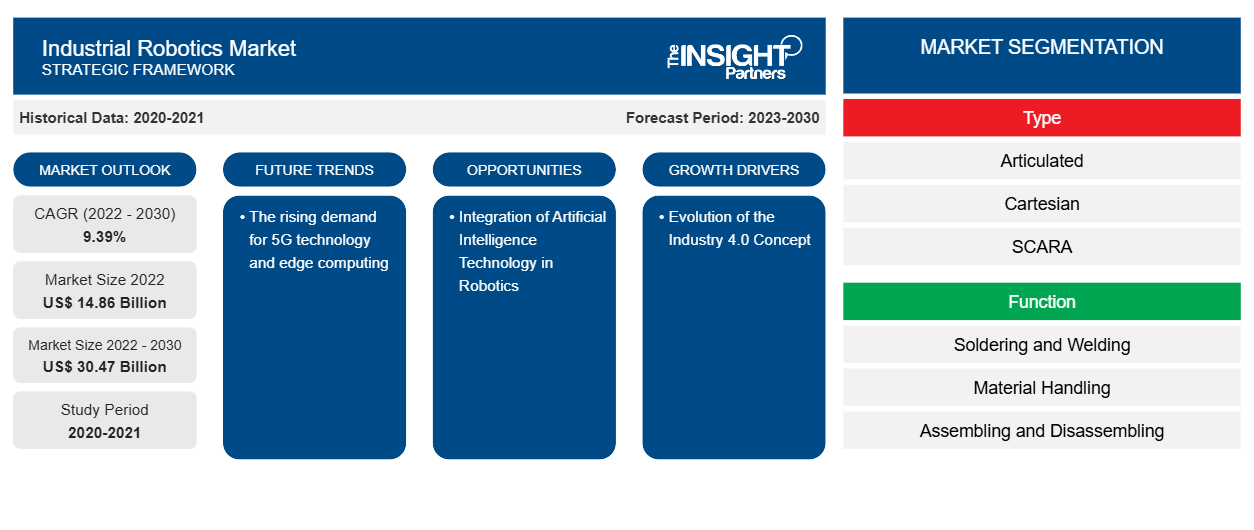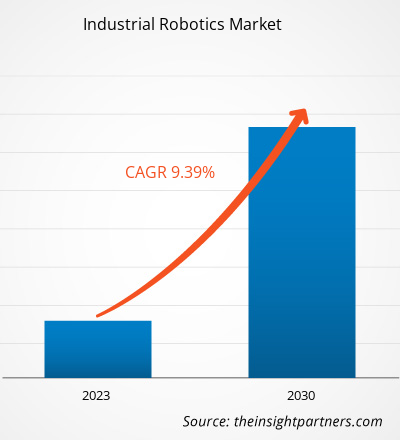Si prevede che la dimensione del mercato della robotica industriale raggiungerà i 30,47 miliardi di dollari entro il 2030, rispetto ai 14,86 miliardi di dollari del 2022. Si prevede che il mercato registrerà un CAGR del 9,39% nel periodo 2022-2030. La crescente domanda di tecnologia 5G e edge computing rimarrà probabilmente una tendenza chiave nel mercato.CAGR of 9.39% during 2022–2030. The rising demand for 5G technology and edge computing is likely to remain a key trends in the market.
Analisi del mercato della robotica industriale
L'evoluzione del concetto di Industria 4.0 e la crescente domanda di robot collaborativi per migliorare l'efficienza operativa stanno guidando il mercato. Si prevede che il mercato crescerà durante il periodo di previsione a causa della crescente domanda di automazione nei settori manifatturiero, dei magazzini e della logistica. Inoltre, l'integrazione della tecnologia di intelligenza artificiale nella robotica sta creando opportunità redditizie per il mercato.
Panoramica del mercato della robotica industriale
La robotica industriale può essere definita come bracci robotici dotati di sensori e controlli in grado di eseguire una varietà di funzioni e operazioni nella creazione di prodotti industriali. Sono programmati per eseguire attività ripetitive in cicli. Questi robot riducono drasticamente gli elementi umani coinvolti nella produzione, aumentando al contempo la velocità di elaborazione, la qualità e la capacità produttiva. Il componente più significativo del robot è senza dubbio il braccio, che è costituito da giunti e connessioni. L'utensile di estremità del braccio (EOAT) è il componente più critico del braccio robotico. Svolgono una varietà di attività, tra cui marcatura, taglio, saldatura, foratura, verniciatura e pulizia.
Personalizza questo report in base alle tue esigenze
Riceverai la personalizzazione gratuita di qualsiasi report, comprese parti di questo report, o analisi a livello nazionale, pacchetto dati Excel, oltre a usufruire di grandi offerte e sconti per start-up e università
- Scopri le principali tendenze di mercato in questo rapporto.Questo campione GRATUITO includerà analisi di dati che spaziano dalle tendenze di mercato alle stime e alle previsioni.
Driver e opportunità del mercato della robotica industriale
Evoluzione del concetto di Industria 4.0 a favore del mercato
L'Industria 4.0 si riferisce all'attuale rivoluzione industriale, che è guidata dai progressi nella robotica, nell'automazione e nell'Internet delle cose (IoT). L'ascesa del lotto industriale e dell'intelligenza artificiale avrà probabilmente un profondo impatto sulla robotica. La tecnologia dell'Industria 4.0 consente nuove strategie di manutenzione, robot autonomi e tecnologie di robotica collaborativa. Si prevede che nuove strategie di manutenzione e intelligenza artificiale avranno un impatto sostanziale sui robot. I robot industriali e le tecnologie dell'Industria 4.0 hanno il potenziale per modificare le aziende nei prossimi anni migliorando la gestione delle macchine e automatizzando le attività precedentemente manuali, il che dovrebbe alimentare la crescita nel mercato della robotica industrialeIoT). The rise of industrial lot and
Integrazione della tecnologia di intelligenza artificiale nella robotica
L'intelligenza artificiale sta guidando notevoli progressi nel settore della robotica e dell'automazione. Man mano che l'intelligenza artificiale nella robotica si evolve e fiorisce, numerose industrie stanno capitalizzando su queste tecnologie all'avanguardia, come l'implementazione di processi automatizzati in modo intelligente per alimentare una raccolta e un'analisi sofisticate dei dati, consentendo alle aziende, ai servizi e ai produttori di prendere decisioni basate sui dati o implementando robot autoapprendenti per facilitare i processi e le attività di lavoro. Si prevede che l'adozione di robot autoapprendenti basati sull'intelligenza artificiale creerà opportunità nel mercato durante il periodo di previsione.
Analisi della segmentazione del rapporto di mercato sulla robotica industriale
I segmenti chiave che hanno contribuito alla derivazione dell'analisi di mercato della robotica industriale sono tipologia, funzione e settore.
- In base al tipo, il mercato della robotica industriale è suddiviso in articolato, cartesiano, SCARA, collaborativo, parallelo e altri. Il segmento articolato ha detenuto una quota di mercato maggiore nel 2022.cartesian, SCARA, collaborative, parallel, and others. The articulated segment held a larger market share in 2022.
- In base alla funzione, il mercato è segmentato in saldatura e saldatura, movimentazione dei materiali, assemblaggio e smontaggio, verniciatura e distribuzione, fresatura e taglio e lavorazione. Il segmento della movimentazione dei materiali ha detenuto una quota di mercato maggiore nel 2022.
- In base al settore, il mercato è suddiviso in automotive, medicale e farmaceutico, elettrico ed elettronico, gomma e plastica, metallo e macchinari e cibo e agricoltura. Il segmento cibo e agricoltura ha detenuto una quota di mercato maggiore nel 2022.
Analisi della quota di mercato della robotica industriale per area geografica
L'ambito geografico del rapporto sul mercato della robotica industriale è suddiviso principalmente in cinque regioni: Nord America, Asia Pacifico, Europa, Medio Oriente e Africa, Sud e Centro America.
Si prevede che il mercato in Europa si espanderà durante il periodo di previsione a causa della crescente domanda di robot industriali. Le installazioni di robot industriali sono aumentate del 33% nel 2021 rispetto al 2020. Nel 2021, l'utilizzo di robot industriali è aumentato del 22% nell'industria elettronica, del 57% nell'industria automobilistica e del 29% nel settore dei metalli e dei macchinari, rispetto al 2020. Secondo IFR, a gennaio 2023, Cina, Giappone e Corea del Sud erano tra i primi cinque paesi più avanzati in termini di installazioni annuali di robot industriali, con il mercato della robotica industriale cinese che ha registrato il più alto sviluppo.
Approfondimenti regionali sul mercato della robotica industriale
Le tendenze regionali e i fattori che influenzano il mercato della robotica industriale durante il periodo di previsione sono stati ampiamente spiegati dagli analisti di Insight Partners. Questa sezione discute anche i segmenti e la geografia del mercato della robotica industriale in Nord America, Europa, Asia Pacifico, Medio Oriente e Africa e America meridionale e centrale.

- Ottieni i dati specifici regionali per il mercato della robotica industriale
Ambito del rapporto sul mercato della robotica industriale
| Attributo del report | Dettagli |
|---|---|
| Dimensioni del mercato nel 2022 | 14,86 miliardi di dollari USA |
| Dimensioni del mercato entro il 2030 | 30,47 miliardi di dollari USA |
| CAGR globale (2022-2030) | 9,39% |
| Dati storici | 2020-2021 |
| Periodo di previsione | 2023-2030 |
| Segmenti coperti | Per tipo
|
| Regioni e Paesi coperti | America del Nord
|
| Leader di mercato e profili aziendali chiave |
|
Densità degli attori del mercato: comprendere il suo impatto sulle dinamiche aziendali
Il mercato della robotica industriale sta crescendo rapidamente, spinto dalla crescente domanda degli utenti finali dovuta a fattori quali l'evoluzione delle preferenze dei consumatori, i progressi tecnologici e una maggiore consapevolezza dei vantaggi del prodotto. Con l'aumento della domanda, le aziende stanno ampliando le loro offerte, innovando per soddisfare le esigenze dei consumatori e capitalizzando sulle tendenze emergenti, il che alimenta ulteriormente la crescita del mercato.
La densità degli operatori di mercato si riferisce alla distribuzione di aziende o società che operano in un particolare mercato o settore. Indica quanti concorrenti (operatori di mercato) sono presenti in un dato spazio di mercato in relazione alle sue dimensioni o al valore di mercato totale.
Le principali aziende che operano nel mercato della robotica industriale sono:
- ABB Ltd
- Società elettrica Yaskawa
- Società Nachi-Fujikoshi
- Robotica Fuji
- KUKA AG
- Robotica universale AS
Disclaimer : le aziende elencate sopra non sono classificate secondo un ordine particolare.

- Ottieni una panoramica dei principali attori del mercato della robotica industriale
Notizie e sviluppi recenti del mercato della robotica industriale
Il mercato della robotica industriale viene valutato raccogliendo dati qualitativi e quantitativi post-ricerca primaria e secondaria, che includono importanti pubblicazioni aziendali, dati associativi e database. Di seguito sono elencati alcuni degli sviluppi nel mercato della robotica industriale:
- ABB Ltd ha ribadito il suo impegno verso uno dei mercati dei suoi clienti più importanti, gli Stati Uniti, avviando la costruzione dell'ampliamento della sua attuale sede centrale di robotica e dell'impianto di produzione ad Auburn Hills, Michigan. Il progetto sarà completato entro novembre 2023 e si prevede che costerà 20 milioni di dollari. L'ampliamento creerà 72 nuovi posti di lavoro altamente qualificati nell'area, supportati da una sovvenzione basata sulle prestazioni di 450.000 dollari dal Michigan Business Development Program. (Fonte: ABB Ltd, sito Web aziendale, marzo 2023)
Copertura e risultati del rapporto sul mercato della robotica industriale
Il rapporto "Dimensioni e previsioni del mercato della robotica industriale (2020-2030)" fornisce un'analisi dettagliata del mercato che copre le seguenti aree:
- Dimensioni e previsioni del mercato della robotica industriale a livello globale, regionale e nazionale per tutti i segmenti di mercato chiave coperti dall'ambito
- Tendenze del mercato della robotica industriale e dinamiche di mercato come driver, vincoli e opportunità chiave
- Analisi dettagliata delle cinque forze PEST/Porter e SWOT
- Analisi di mercato della robotica industriale che copre le principali tendenze di mercato, il quadro globale e regionale, i principali attori, le normative e i recenti sviluppi del mercato
- Analisi del panorama industriale e della concorrenza che copre la concentrazione del mercato, l'analisi della mappa di calore, i principali attori e gli sviluppi recenti per il mercato della robotica industriale
- Profili aziendali dettagliati
- Analisi storica (2 anni), anno base, previsione (7 anni) con CAGR
- Analisi PEST e SWOT
- Valore/volume delle dimensioni del mercato - Globale, regionale, nazionale
- Industria e panorama competitivo
- Set di dati Excel



Report Coverage
Revenue forecast, Company Analysis, Industry landscape, Growth factors, and Trends

Segment Covered
This text is related
to segments covered.

Regional Scope
North America, Europe, Asia Pacific, Middle East & Africa, South & Central America

Country Scope
This text is related
to country scope.
Domande frequenti
The rising demand for 5G technology and edge computing to play a significant role in the global industrial robotics market in the coming years.
The key players holding majority shares in the global industrial robotics market are ABB Ltd, Yaskawa Electric Corporation, Nachi-Fujikoshi Corp, Fuji Robotics, KUKA AG, Universal Robotics AS, Honeybee Robotics, COMAU SPA, and Clearpath Robotics Inc.
The global industrial robotics market is expected to reach US$ 30.47 billion by 2030.
The global industrial robotics market is estimated to register a CAGR of 9.39% during the forecast period 2022–2030.
Asia Pacific dominated the industrial robotics market in 2022.
The evolution of the Industry 4.0 Concept and the growing demand for collaborative robots for enhancing operational efficiency are the major factors that propel the global industrial robotics market.
Trends and growth analysis reports related to Electronics and Semiconductor : READ MORE..
The List of Companies - Industrial Robotics Market
- ABB Ltd
- Yaskawa Electric Corporation
- Nachi-Fujikoshi Corp
- Fuji Robotics
- KUKA AG
- Universal Robotics AS
- Honeybee Robotics
- COMAU SPA
- Clearpath Robotics Inc
- Staubli International AG
The Insight Partners performs research in 4 major stages: Data Collection & Secondary Research, Primary Research, Data Analysis and Data Triangulation & Final Review.
- Data Collection and Secondary Research:
As a market research and consulting firm operating from a decade, we have published and advised several client across the globe. First step for any study will start with an assessment of currently available data and insights from existing reports. Further, historical and current market information is collected from Investor Presentations, Annual Reports, SEC Filings, etc., and other information related to company’s performance and market positioning are gathered from Paid Databases (Factiva, Hoovers, and Reuters) and various other publications available in public domain.
Several associations trade associates, technical forums, institutes, societies and organization are accessed to gain technical as well as market related insights through their publications such as research papers, blogs and press releases related to the studies are referred to get cues about the market. Further, white papers, journals, magazines, and other news articles published in last 3 years are scrutinized and analyzed to understand the current market trends.
- Primary Research:
The primarily interview analysis comprise of data obtained from industry participants interview and answers to survey questions gathered by in-house primary team.
For primary research, interviews are conducted with industry experts/CEOs/Marketing Managers/VPs/Subject Matter Experts from both demand and supply side to get a 360-degree view of the market. The primary team conducts several interviews based on the complexity of the markets to understand the various market trends and dynamics which makes research more credible and precise.
A typical research interview fulfils the following functions:
- Provides first-hand information on the market size, market trends, growth trends, competitive landscape, and outlook
- Validates and strengthens in-house secondary research findings
- Develops the analysis team’s expertise and market understanding
Primary research involves email interactions and telephone interviews for each market, category, segment, and sub-segment across geographies. The participants who typically take part in such a process include, but are not limited to:
- Industry participants: VPs, business development managers, market intelligence managers and national sales managers
- Outside experts: Valuation experts, research analysts and key opinion leaders specializing in the electronics and semiconductor industry.
Below is the breakup of our primary respondents by company, designation, and region:

Once we receive the confirmation from primary research sources or primary respondents, we finalize the base year market estimation and forecast the data as per the macroeconomic and microeconomic factors assessed during data collection.
- Data Analysis:
Once data is validated through both secondary as well as primary respondents, we finalize the market estimations by hypothesis formulation and factor analysis at regional and country level.
- Macro-Economic Factor Analysis:
We analyse macroeconomic indicators such the gross domestic product (GDP), increase in the demand for goods and services across industries, technological advancement, regional economic growth, governmental policies, the influence of COVID-19, PEST analysis, and other aspects. This analysis aids in setting benchmarks for various nations/regions and approximating market splits. Additionally, the general trend of the aforementioned components aid in determining the market's development possibilities.
- Country Level Data:
Various factors that are especially aligned to the country are taken into account to determine the market size for a certain area and country, including the presence of vendors, such as headquarters and offices, the country's GDP, demand patterns, and industry growth. To comprehend the market dynamics for the nation, a number of growth variables, inhibitors, application areas, and current market trends are researched. The aforementioned elements aid in determining the country's overall market's growth potential.
- Company Profile:
The “Table of Contents” is formulated by listing and analyzing more than 25 - 30 companies operating in the market ecosystem across geographies. However, we profile only 10 companies as a standard practice in our syndicate reports. These 10 companies comprise leading, emerging, and regional players. Nonetheless, our analysis is not restricted to the 10 listed companies, we also analyze other companies present in the market to develop a holistic view and understand the prevailing trends. The “Company Profiles” section in the report covers key facts, business description, products & services, financial information, SWOT analysis, and key developments. The financial information presented is extracted from the annual reports and official documents of the publicly listed companies. Upon collecting the information for the sections of respective companies, we verify them via various primary sources and then compile the data in respective company profiles. The company level information helps us in deriving the base number as well as in forecasting the market size.
- Developing Base Number:
Aggregation of sales statistics (2020-2022) and macro-economic factor, and other secondary and primary research insights are utilized to arrive at base number and related market shares for 2022. The data gaps are identified in this step and relevant market data is analyzed, collected from paid primary interviews or databases. On finalizing the base year market size, forecasts are developed on the basis of macro-economic, industry and market growth factors and company level analysis.
- Data Triangulation and Final Review:
The market findings and base year market size calculations are validated from supply as well as demand side. Demand side validations are based on macro-economic factor analysis and benchmarks for respective regions and countries. In case of supply side validations, revenues of major companies are estimated (in case not available) based on industry benchmark, approximate number of employees, product portfolio, and primary interviews revenues are gathered. Further revenue from target product/service segment is assessed to avoid overshooting of market statistics. In case of heavy deviations between supply and demand side values, all thes steps are repeated to achieve synchronization.
We follow an iterative model, wherein we share our research findings with Subject Matter Experts (SME’s) and Key Opinion Leaders (KOLs) until consensus view of the market is not formulated – this model negates any drastic deviation in the opinions of experts. Only validated and universally acceptable research findings are quoted in our reports.
We have important check points that we use to validate our research findings – which we call – data triangulation, where we validate the information, we generate from secondary sources with primary interviews and then we re-validate with our internal data bases and Subject matter experts. This comprehensive model enables us to deliver high quality, reliable data in shortest possible time.


 Ottieni un campione gratuito per questo repot
Ottieni un campione gratuito per questo repot